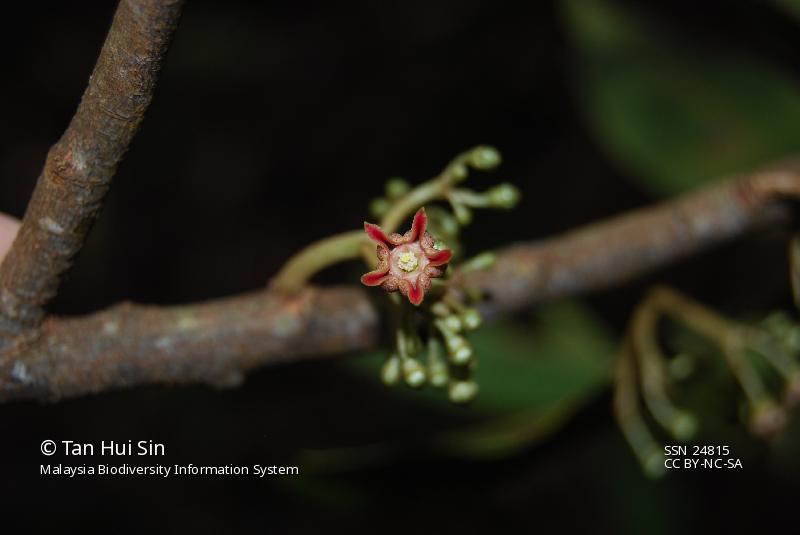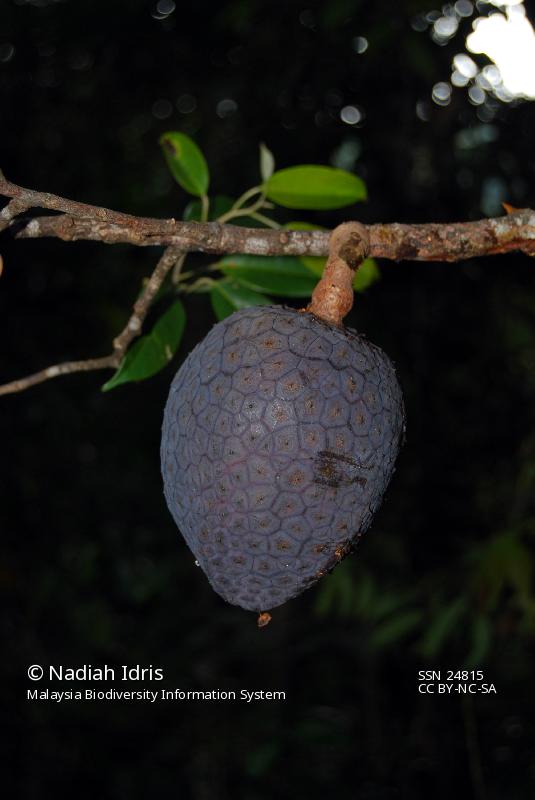
Close up of open flower
Coelostegia is a small genus in the subfamily Helicteroideae-Durioneae, family Bombacaceae or Malvaceae from western Malesia (Peninsular Malaysia, Singapore, Java, Sumatra and Borneo). Prior to 1998, taxonomic and systematic studies based mainly on morphological and anatomical characters carried out by various authors (e.g., Hutchinson 1959, Keng 1969) included Coelostegia in the tribe/section Durioneae of the family Bombacaceae. From the late 1990’s, however, phylogenetic studies based on chloroplast and nuclear ribosomal DNA (e.g., Nyffeler & Baum 2000, Bayer & Kubitzki 2003) strongly suggested that the core Malvales families (Bombacaceae, Malvaceae, Sterculiaceae and Tiliaceae) be merged into an expanded family Malvaceae, and that nine subfamilies should be recognised, with the genera of the Durioneae-group to be included in subfamily Helicteroideae-Durioneae. Cheek (2006, 2007), however, disagreed and proposed placing the Durioneae genera (including Coelostegia, Durio, Kostermansia and Neesia) in a separate family, the Durionaceae.
Coelostegia was first described by Bentham & Hooker in 1862. Coelostegia and other genera in the family are very difficult to distinguish from vegetative characters alone. Flower and fruit characters are very important for species recognition. Gross morphological and micro-morphological characters show that the genus Coelostegia can be readily distinguished from other genera in the family by the epicalyx being much shorter than the calyx, the induplicate-saccate calyx (having edges or margins folded inward/sac-shaped) character and the ovary being partly enclosed by the receptacle. This distinction is also supported by micro-morphological characters derived from trichomes, stomata and pollen.
A revision of the genus Coelostegia in Peninsular Malaysia and Borneo was conducted resulting in the recognition of six species. These are the common C. borneenis which occurs more or less throughout Peninsular Malaysia, Sumatra and Borneo, C. griffithii which is common and recorded from Peninsular Malaysia, Singapore, Java, Sumatra and Borneo, and four other species, i.e. C. chartacea, C. kostermansii, C. montana and C. neesiocarpa which occur only on Borneo Island (Nadiah & Soepadmo, 2011).
Coelostegia montana was formally described as a new species by Kade Sidiyasa in 2001 (Sidiyasa, 2001) based on fruiting specimens from Bukit Batu Tibang, Kapit, Sarawak (Anderson S 28461) and young flower buds from Kayan Mentarang National Park, East Kalimantan, Indonesia (Sidiyasa & Arifin 1529). During field work at the Rafflesia Information Centre, Tambunan, Sabah in 2008, this species was found along the Rafflesia trail at 1342 m altitude, in lower montane forest. The specimen collected from the area (Nadiah et al. SAN 149577), bearing matured fruits and fully developed flowers, represents a new record of this species for the state, thus extending its distribution in Borneo (Nadiah & Soepadmo, 2011).
Coelostegia montana is a large tree, reaching heights of up to 50 m and 45 cm diameter. It has narrow buttresses, shallowly fissured, reddish brown bark, and the leaves are simple alternate arranged, with a leathery texture, elliptic or slightly obovate in shape with acute base and shortly acuminate apex. This species can be distinguished from other Coelostegia species by having leaves with 7–8 pairs of lateral leaf veins; approximately 6 mm long and narrowly obovate stipules; and depressed conical flower buds about 3 mm in diameter. The most unique and attractive part of this species is the subglobose, dark bluish fruits which have a rounded base and are about 12 cm long and 10 cm in diameter. The outer surface of the fruit is submuricate (less rough with small and less sharp spines) and the inside wall is glabrous, brownish and rough. The seeds are pale white when young, turning shiny brown when matured.
This species can be found growing in dipterocarp and submontane primary forests, on ridges, well-drained soils, on igneous (andesitic) derived soil or on slopes. The epithet montana is derived from the Latin name montanus, meaning growing on mountains. Apart from the morphological characters, this species has a distinct altitudinal distribution pattern and is only found at high altitudes (approximately 884–1450 m altitude) while all the other Coelostegia species occur in the lowlands (c. 20–606 m altitude).
Coelostegia montana has not yet been assessed for the IUCN Red List. It is considered an endemic in Borneo as it is confined to three localities only (Sabah, Sarawak and Kalimantan).

Dark blue fruit
